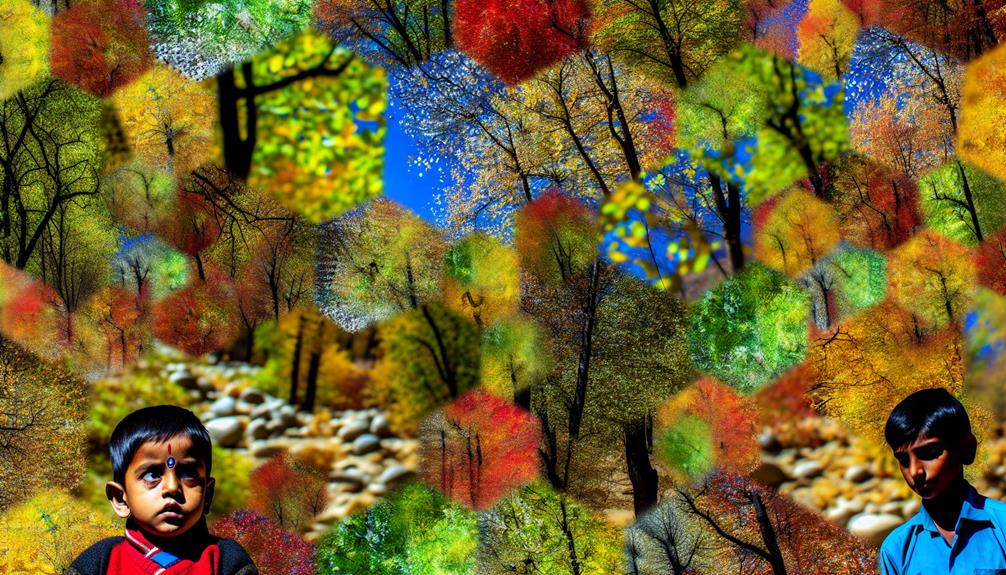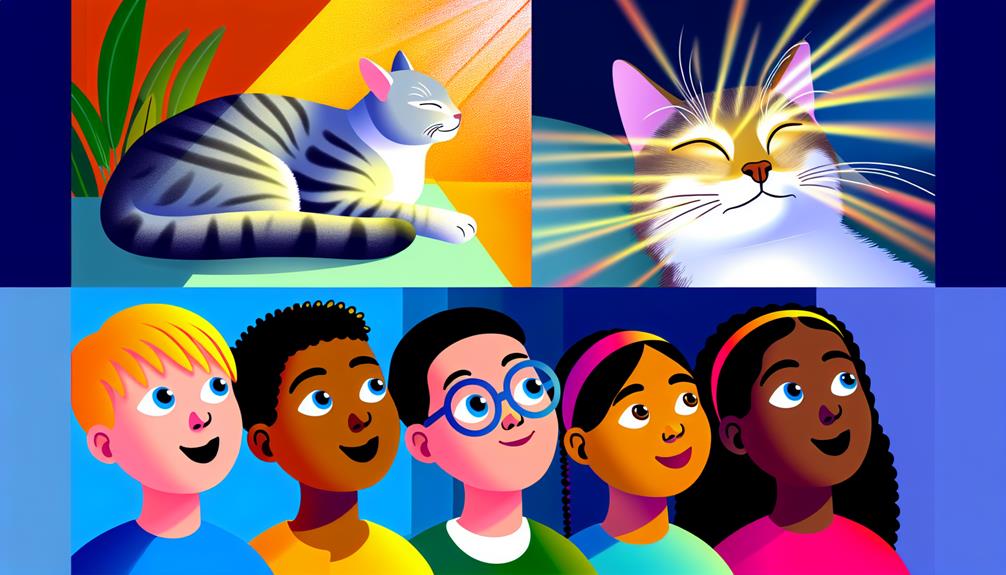Children often pose inquisitive questions about the world around them, ranging from why the sky is blue to what happens after we die. These questions touch on various topics, such as natural phenomena like rainbows and thunder, the behavior of animals like cats, and even profound philosophical inquiries. Each query reflects a child's desire to understand their environment and connect with deeper concepts. By exploring the science of flight or the reasons behind yawning, we can foster their curiosity and appreciation for nature and life. Discovering answers to these questions can open new avenues of wonder and insight.
Key Takeaways
- Kids often ask why the sky is blue, which is due to atmospheric scattering of sunlight, particularly blue light.
- Another common question is how rainbows form, which occurs through sunlight interacting with water droplets, causing light refraction.
- Children are curious about why leaves change color in autumn, linked to the breakdown of chlorophyll and the reveal of other pigments.
- Questions about thunder and lightning arise from their natural curiosity about weather phenomena, with thunder resulting from rapid air expansion caused by lightning.
- Kids frequently wonder about purring in cats, which can indicate contentment, distress, or a means of communication, reflecting their emotional state.
Why Is the Sky Blue?

Many people, including curious children, often wonder why the sky appears blue on clear days. This enchanting phenomenon is primarily due to a process known as atmospheric scattering. When sunlight enters Earth's atmosphere, it interacts with air molecules and small particles. Sunlight consists of various colors, each with different wavelengths. Blue light, having a shorter wavelength, scatters more than the other colors when it strikes these molecules. This is similar to how various nutrients can be portioned out on a plate to create a balanced meal, ensuring that we get a variety of essential elements in our diet mastering healthy meals.
This scattering causes the blue light to spread across the sky, enhancing our color perception in that direction. As we look up, our eyes detect this scattered blue light, giving the sky its characteristic hue. It's fascinating to note that the sky can appear different colors during sunrise and sunset; here, the light travels through more atmosphere, scattering shorter wavelengths and allowing warmer colors, like reds and oranges, to dominate.
Understanding the reasons behind the blue sky can foster a sense of connection to nature and science. It reminds us of the intricate workings of our world, inviting everyone, especially young minds, to explore and appreciate the beauty surrounding them.
How Are Rainbows Formed?
After exploring the enchanting reasons behind the blue sky, another intriguing natural phenomenon that piques the interest of children and adults alike is the rainbow. Rainbows emerge when sunlight interacts with water droplets in the atmosphere. This fascinating spectacle begins with light refraction, which occurs as sunlight enters a raindrop.
Inside the droplet, the light bends and spreads into its component colors, creating a beautiful color spectrum. Each color—red, orange, yellow, green, blue, indigo, and violet—has a different wavelength, causing them to refract at slightly different angles. As the light exits the droplet, it refracts again, resulting in the circular arc we recognize as a rainbow.
This natural wonder often appears after a rainstorm when the sun shines through lingering droplets in the air. For many, it symbolizes hope and beauty, fostering a sense of connection to nature. It reminds us that even after the rain, splendor can emerge, inviting us to marvel at the world around us. Understanding how rainbows are formed can deepen our appreciation for these vibrant displays and the science behind them.
Why Do Leaves Change Color?

As summer shifts to fall, many children wonder why leaves change color, turning vibrant shades of red, orange, and yellow. This fascinating process is primarily influenced by photosynthesis and the pigments present in the leaves, which respond to seasonal weather changes. As the days shorten and temperatures drop, chlorophyll breaks down, revealing other pigments like carotenoids and anthocyanins. Understanding these natural transformations can help us appreciate the beauty of nature and the science behind it, much like how high-fiber pasta options can enhance our diets for better health.
Photosynthesis and Pigments
Understanding the intricate processes of photosynthesis reveals why leaves undergo a stunning transformation in color during the autumn months. At the heart of this process is chlorophyll, the pigment responsible for the vibrant green hue of leaves. Chlorophyll functions by capturing sunlight to convert carbon dioxide and water into plant energy. This energy fuels the growth and sustenance of the plant throughout the warmer months.
As daylight hours shorten and temperatures drop in autumn, chlorophyll production slows, leading to a decline in its concentration. This gradual fading allows other pigments, such as carotenoids and anthocyanins, to emerge. Carotenoids contribute yellow and orange hues, while anthocyanins produce reds and purples. The interplay of these pigments creates the breathtaking tapestry of colors we associate with fall.
This seasonal change is not just a beautiful spectacle; it signifies the plant's preparation for winter. By understanding these processes, we not only appreciate the beauty around us but also feel a sense of belonging to the natural world, recognizing the cycles that connect us to all living things.
Seasonal Weather Effects
The stunning transformation of leaves in autumn is not solely a result of pigment changes but is also greatly influenced by seasonal weather effects. As summer wanes, shorter days and cooler temperatures signal trees to prepare for winter. This change prompts the production of chlorophyll, the green pigment, to slow down, revealing other pigments like carotenoids and anthocyanins, which create vibrant yellows, oranges, and reds.
Moreover, seasonal patterns, such as rainfall and sunlight, play vital roles in this transformation. A wet spring followed by a dry summer can lead to more brilliant colors, as trees focus their energy on producing pigments. However, the impact of climate change cannot be ignored. Altered weather patterns may disrupt these natural cycles, potentially leading to muted colors or delayed leaf changes.
Understanding these processes fosters a connection to nature and highlights the delicate balance within our ecosystems. As we witness these beautiful transformations, we also cultivate a sense of responsibility to protect our environment. Engaging with the changing seasons not only enriches our lives but also nurtures our collective belonging to the natural world.
What Causes Thunder and Lightning?
Many people are fascinated by the dramatic display of thunder and lightning during a storm, yet few understand the science behind these powerful phenomena. Thunder is formed when lightning rapidly heats the air around it, causing the air to expand explosively. This rapid expansion creates sound waves, which we hear as thunder. The intensity and distance of the thunder can vary based on the conditions of the atmosphere.
Lightning occurs when there is an imbalance between positive and negative charges in the atmosphere. This buildup of electrical energy discharges in the form of lightning, which can be both beautiful and dangerous. Understanding these concepts is essential not only for curiosity's sake but also for lightning safety.
| Aspect | Thunder | Lightning |
|---|---|---|
| Formation | Rapid air expansion | Electrical discharge |
| Sound | Heard as thunder | Not heard, but seen |
| Safety Tips | Stay indoors during storms | Avoid tall objects and water |
Why Do We Yawn?

As we explore the intricacies of natural phenomena, we are reminded that the human body also holds its own mysteries, such as the seemingly simple act of yawning. Yawning is often associated with tiredness or boredom, but its reasons extend beyond this common perception. When we yawn, our body may be signaling a need for increased oxygen intake or a cooling mechanism for our brain. This biological response can also be a reflection of our surroundings and social environment, much like how individuals might seek care in places like Fairview Nursing Care Center for a supportive community.
Interestingly, yawning is not solely an individual activity; it can be contagious. This phenomenon, known as social yawning, reflects our innate social connections. When we see someone yawn, our mirror neurons may activate, prompting us to do the same. This instinctive behavior fosters a sense of belonging and empathy within groups, encouraging a shared experience.
Understanding the yawning reasons enriches our appreciation of how interconnected we are, not just as individuals, but as members of a community. Next time you find yourself yawning in a meeting or while watching a friend, remember that this simple act is a fascinating interplay of biology and social bonding, reminding us of our shared humanity in the most unexpected moments.
How Do Planes Fly?
Have you ever wondered how planes soar gracefully through the sky? The secret lies in a fascinating combination of lift, engine power, and aerodynamics, all working together to defy gravity. Different wing designs can optimize lift and reduce drag, which is vital for efficient flight. Understanding wing design and thrust helps us appreciate the incredible engineering behind flight and the science that makes it possible, including the best display technologies for understanding flight simulations and visualizations.
The Science of Lift
Soaring high above the ground, airplanes defy gravity through the fascinating science of lift. This essential force allows aircraft to rise and navigate through the skies, providing an incredible sense of connection to our world and each other. The magic of lift generation occurs when air travels over and under the wings of an airplane. The wings are designed with a special shape known as an airfoil, which facilitates a difference in air pressure.
As the airplane moves forward, air flows faster over the curved top surface of the wing and slower beneath it. This difference in speed creates a variation in air pressure: lower pressure above the wing and higher pressure below. The resulting force pushes the wings upward, allowing the plane to ascend.
Understanding lift fosters a sense of wonder and belonging to the broader community of aviation enthusiasts. It illustrates how science enables us to explore our planet from above, connecting us in ways we often take for granted. By grasping the principles of lift, we can appreciate the ingenuity behind flight and the shared experience of traveling through the skies.
Engine Power and Thrust
Understanding lift provides a glimpse into one of the fundamental aspects of flight, but it's equally important to contemplate the role of engine power and thrust in enabling aircraft to soar through the skies. Aircraft engines generate thrust, which propels the plane forward, overcoming drag and allowing the wings to generate lift. The efficiency of these engines plays a significant role in determining how far and fast a plane can travel.
Engine power is measured with respect to thrust mechanics, which refers to the way engines convert fuel into forward motion. Higher engine efficiency means more thrust with less fuel, leading to longer journeys and reduced environmental impact.
Here's a simple table to illustrate the relationship between engine power, thrust, and flight:
| Aspect | Description | Importance |
|---|---|---|
| Engine Power | The total power produced by the engine | Determines maximum thrust |
| Thrust Mechanics | How engines create thrust | Enables planes to overcome drag |
| Engine Efficiency | The ratio of useful power output to fuel used | Reduces costs and enhances range |
Understanding these concepts helps us appreciate the engineering marvels that allow us to fly.
Aerodynamics and Wing Design
Harnessing the principles of aerodynamics, aircraft designers create wings that are not only efficient but also vital for achieving flight. The design of wings, often referred to as airfoils, plays a pivotal role in lift generation, enabling planes to rise into the sky. By carefully shaping airfoil profiles, engineers reduce drag, allowing for smoother flight and enhanced overall flight efficiency.
The evolution of wing design has been a fascinating journey, marked by advancements in understanding turbulence effects and stability control. Modern wings are crafted from advanced materials, ensuring they are lightweight yet strong enough to withstand the forces encountered during flight. The delicate balance between lift generation and drag reduction is significant; too much drag can hinder performance while insufficient lift can prevent takeoff.
As we explore the world of aviation, it is important to recognize that each design decision contributes to the seamless experience of flying. Together, we celebrate the ingenuity behind aircraft wings, fostering a sense of belonging in this shared fascination with flight. Understanding these principles not only answers our curious questions but also deepens our appreciation for the marvels of aviation.
Why Do Cats Purr?

Cats purr for a variety of reasons, and this soothing sound often captivates pet owners and animal lovers alike. While many associate purring with contentment, feline behavior reveals that this unique form of cat communication serves multiple purposes. For instance, cats frequently purr when they are relaxed, signaling a state of comfort and trust in their surroundings. Curiously, much like the nuanced flavors of different beans, the reasons behind purring can vary; some cats may purr when they seek attention or reassurance, while others may do so when they are in pain, similar to how the taste profiles of red beans vs. kidney beans can influence their culinary uses.
However, purring can also occur in moments of distress or pain, acting as a self-soothing mechanism. Research suggests that the vibrations produced during purring may promote healing and reduce stress, reflecting the complex emotional lives of our feline friends.
Additionally, mother cats purr to communicate with their kittens, guiding them and fostering a sense of security. This early form of communication helps strengthen their bond, highlighting the importance of purring in cat socialization.
Understanding why cats purr allows us to connect more deeply with them, enhancing our relationships. By recognizing the nuances of their vocalizations, we can provide the care and support they need, ensuring a harmonious coexistence. Ultimately, the gentle rumble of a purring cat is a reminder of the rich emotional tapestry that defines our bond with these beloved companions.
What Happens After We Die?
Although the question of what happens after we die has fascinated humanity for centuries, it remains one of life's greatest mysteries, invoking a wide range of beliefs and emotions. Different cultures and religions offer various death beliefs and afterlife concepts, shaping how individuals understand existence beyond this life.
Many spiritual views suggest a continuation of the soul, while others focus on the legacy thoughts left behind in the memories of loved ones. This divergence reflects the rich tapestry of human experience, where cultural rituals surrounding death serve not only as a means of honoring those who have passed but also as a source of comfort for the living.
Grief understanding plays an essential role in this conversation, as it helps individuals navigate their feelings and find solace in shared beliefs. Engaging with these existential questions can foster connections with others who seek answers, creating a sense of belonging amidst uncertainty. Ultimately, while the specifics may remain unknown, the discussions surrounding life after death can unite us in our shared humanity, helping us find meaning in our lives and the legacies we create.
Frequently Asked Questions
Why Do We Dream and What Do Dreams Mean?
Dreams occur during the REM stage of sleep cycles, serving various psychological functions including emotional processing and problem-solving. Dream interpretation can offer insights into our subconscious thoughts and feelings, often reflecting our daily experiences and emotions. While the meanings of dreams can vary greatly, they may symbolize desires, fears, or unresolved conflicts. Engaging with our dreams can foster a sense of belonging within ourselves, promoting self-awareness and personal growth.
How Do Fish Breathe Underwater Without Drowning?
Fish possess specialized organs known as gills, which play an essential role in their ability to breathe underwater. The gills function by extracting oxygen from the water as it flows over them, facilitating oxygen absorption into the fish's bloodstream. This remarkable adaptation allows fish to thrive in aquatic environments without the risk of drowning. Understanding these processes fosters a deeper appreciation for marine life, enhancing our connection to the diverse ecosystems that inhabit our planet.
Why Do We Have Different Blood Types?
Blood types, classified as A, B, AB, or O, arise from genetic inheritance, determining the presence of specific antigens on red blood cells. These variations influence immune response, as individuals may react differently to foreign blood types. Understanding blood type is essential for transfusion compatibility, ensuring safe blood transfusions. This knowledge fosters a sense of belonging within communities, as individuals with compatible blood types can support one another during medical needs, enhancing collective wellness.
What Makes Popcorn Pop and Why Does It Taste Good?
Popcorn's delightful popping phenomenon is rooted in popcorn science. Each kernel contains moisture within a hard shell; when heated, the moisture turns to steam, building pressure until the kernel bursts. This transformation creates the fluffy snack we adore. Flavor factors such as seasoning and the Maillard reaction during cooking enhance its taste, making popcorn not only a fun treat but also a communal experience, perfect for gatherings and movie nights, fostering connection and enjoyment.
Why Do Some Animals Hibernate During Winter?
Hibernation is a remarkable example of animal adaptations for winter survival. During colder months, certain animals, such as bears and ground squirrels, enter a state of dormancy to conserve energy and maintain body heat. This process allows them to survive when food is scarce and environmental conditions become harsh. By understanding hibernation, we can appreciate the resilience of these creatures and their ability to thrive in challenging circumstances, fostering a sense of connection with the natural world.




